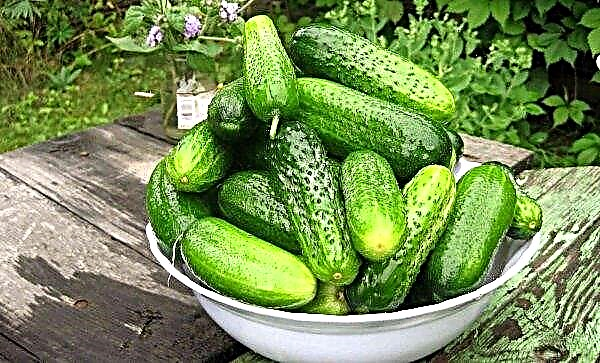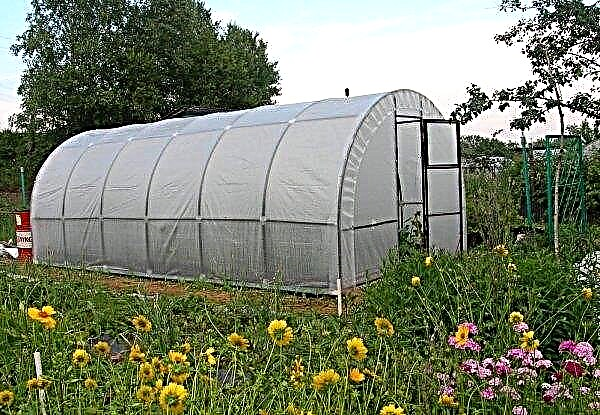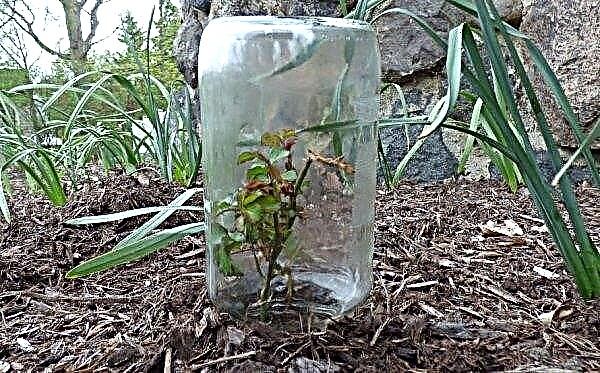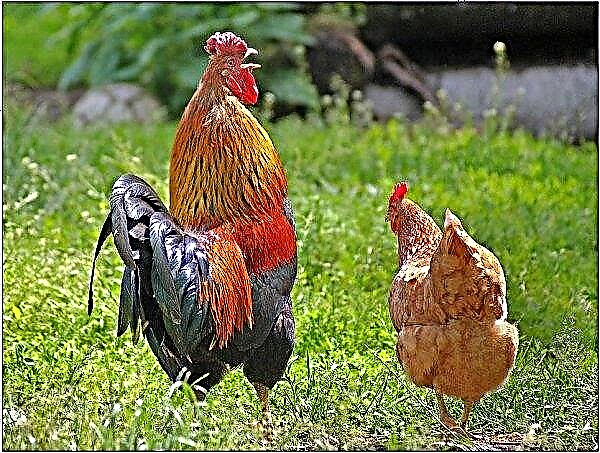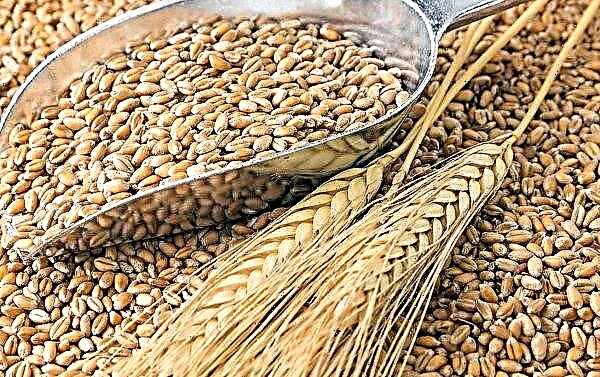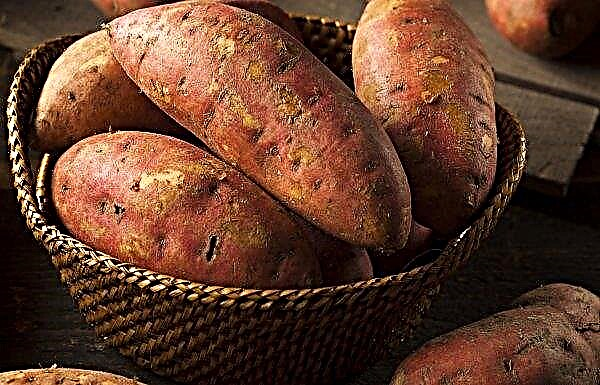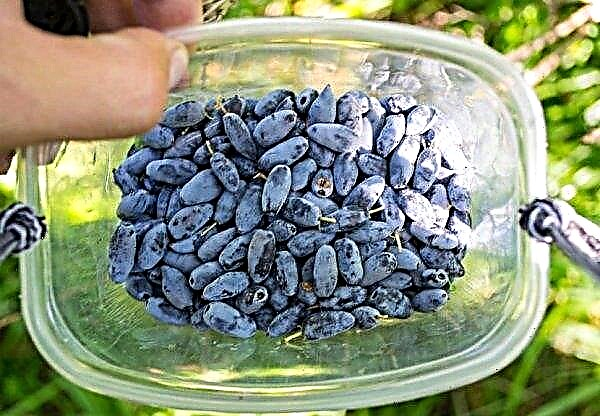Eggplant is a close relative of tomato and potato and is not eaten raw. It contains a large number of vitamins and minerals useful for the human body. The Black Prince variety is a vivid representative of this type of vegetables, which is characterized by high productivity, good transportability and high quality products. Read more about this variety later in the article.
Selection and botanical description of the culture
The Black Prince eggplant was bred by the breeders of the Russian company Gavrish and included in the State Register in 2017. It is planted in greenhouses, and seeds can be sown in open ground only in the southern regions. This variety refers to annual mid-early plants.
It is characterized by such qualities:
- Forms a bush of medium height (60–80 cm).
- The stems are half-empty, saturated green, and during the ripening of the fruits - dark purple, which is one of the distinguishing features of the Black Prince from other varieties. The second difference is that there are no thorns on the flower cup.
- Leaves are medium sized, fleecy, green.
- Fruits are slightly curved, cylindrical or pear-shaped, with a diameter of 8–12 cm and a length of 20 cm, the weight of one fruit is up to 200 g.
- The peel is thin, the color of the skin in technical ripeness is rich purple, and in biological ripeness it is purple-black with a glossy sheen.
- The pulp is light yellow in color, contains a small amount of grains, has a pleasant taste with barely noticeable bitterness.

Advantages and disadvantages
- The main positive qualities of the Black Prince variety are:
- high productivity, which can reach up to 6–8 kg per 1 m²;
- long shelf life;
- perfectly transported over long distances;
- has a good presentation;
- possesses high tastes;
- not picky about the composition of the soil;
- resistant to diseases such as late blight, powdery mildew;
- universal in cooking.
- However, it also has some disadvantages, which include the following:
- does not grow in dark areas;
- Do not plant tomatoes, peppers and potatoes nearby.
Did you know? Before eggplant began to be used in cooking, they were grown in Italian gardens as an ornamental plant.
Self-growing seedlings
Black Prince eggplant seedlings are easy to grow on their own. The main thing is to follow the basic rules and conditions to get a good and effective result.
Sowing time
The optimal period for sowing seeds is the second half of February - early March, 50-60 days before transplanting seedlings to a permanent place.
The soil
10-14 days before sowing planting material, it is necessary to prepare the soil in which Black Prince eggplant seeds will be sown.
To do this, you need:
- mix in equal parts plain earth from the garden, sand and peat or humus;
- disinfect the land with special preparations (Iskra, Aktara, Thunder, etc.);
- normalize the acid-base balance of the earth with wood ash, slaked lime, chalk, hydrogel.
The soil should be light, loose, with enough micro and macro elements, absorb moisture well and hold it, have the necessary acidity, without weed seeds, fungal spores, toxins, without decomposition.
Important! Eggplant Black Prince is a variety, not a hybrid, so you can get viable seeds from it.
Capacity for growing
Different capacities are suitable for growing eggplant seedlings, but the specifics of the eggplant seedling itself must be taken into account.
Such containers include:
- Wooden or plastic crates - should be 8-10 cm high, with drainage holes. These boxes are convenient in that they are inexpensive, and when germinating, all seedlings are in one place. If necessary, you can transfer everything, turn the other side. However, it should be remembered that when thinning, diving and planting in open ground, seedlings can be damaged, they will recover for a long time and hurt.
- Individual cups - advantageous in that they do not take up much space, are inexpensive and can be used many times, have separate openings for water drainage. Seedlings in such containers do not outgrow, 1 glass falls on 1 plant, and seedlings are easier to take out for planting in the ground. However, there are downsides to this capacity: the soil dries quickly, the walls of the cups are very thin and crumple with strong pressure, and their height may not be enough for the root eggplant system.
- Peat pills - are pressed peat with added nutrients. The advantages are that the walls of the tablets are porous, allow air and water to pass through. Seedlings are planted in the soil along with tablets, which ensures almost 100% plant survival, and peat serves as an additional fertilizer. The disadvantages include high cost, one-time use, and the fact that there will be few such volumes for eggplant seedlings, and you will have to transplant them again later in larger containers.

Seed preparation
For future plants to grow healthy and strong, you must first prepare the seeds for sowing.
This consists of the following sequence of actions:
- soak the seed in a weak solution of potassium permanganate for 20-30 minutes;
- rinse with clean water at room temperature;
- after that, place the planting material in a stimulating solution (Energen, Zircon, Novosil, etc.) for 1-2 hours;
- dry without rinsing;
- hardening: pour seeds into a moderately moistened bag and place it on the bottom shelf of the refrigerator for 2 days, then take it out for 1 day in a warm place with a temperature of +25 ... + 30 ° С - and again for 2 days in the refrigerator.
Sowing seeds
Having finished all the activities for preparing the seed for sowing, it is necessary to start the process itself, which looks like this:
- When sowing planting material in boxes, slightly compact the soil with a layer of 6–8 cm. Make grooves to a width of 5–6 from one another, pour water at room temperature. In the grooves, put seeds at a distance of 2 cm from each other and to a depth of 1–1.5 cm. Burrow the grooves, lightly tamp, cover with a film or glass.
- When sowing in separate containers, put 2-3 seeds in each cup or tablet to a depth of 1-1.5 cm, cover with glass or film until the first shoots appear.

Seedling Care
Care includes the following requirements:
- After sowing seeds, place the container in a dark place with a temperature of +25 ... + 30 ° С - for example, near the battery.
- After the first sprouts sprout, take out the seedlings in daylight and lower the temperature to +15 ... + 20 ° С.
- Cover overnight with a dark film.
- Water only at room temperature once a week. Moreover, the first days of seedlings can be sprayed, and when it gets stronger - to water under the root, avoiding moisture on the leaves.
- Fertilize with watering. In the first 2 weeks, you can use a very weak solution of potassium permanganate, in the following weeks, fertilize with chemical dressings (superphosphate, ammonium sulfate, potassium salt) or organic (chicken droppings, slurry, mullein). Chemicals are best alternated after 12-14 days, and organic give 1 time in 30 days.
Seedling hardening
Before planting seedlings in open ground, it must be hardened.
To do this, you must:
- start hardening 10-14 days before planting;
- reduce the amount of watering;
- increase ventilation by opening plants - first in the daytime, then for a whole day;
- 5-10 days before planting, treat the seedlings with 0.5% solution of copper sulfate.
Planting seedlings in a permanent place
When all procedures for the cultivation, care and hardening of seedlings are completed, you can begin to move it to the garden.
Transplant Dates
The optimal conditions for planting Black Prince eggplant seedlings are as follows:
- landing time - early June, when the air temperature has stabilized and there is no risk of night frosts;
- the temperature during the day should be +20 ... + 25 ° С, at night - up to + 15 ° С;
- seedlings should be 20–25 cm high, with a good root system, 50–60 days old, have at least 6–8 leaves;
- the soil should warm up to a temperature of + 15 ° C to a depth of 15–20 cm.
Important! Eggplants do not like sudden changes in temperature, so if there is a threat of cooling, they need to be covered with a film.
Seat selection and crop rotation
An important role in the cultivation of Black Prince eggplant is played by the place of planting and crop rotation:
- eggplant should not be planted after other solanaceous plants - tomatoes, potatoes, peppers;
- the proximity to garlic and fennel should be avoided;
- it is best to plant eggplant seedlings after legumes, pumpkins, cucumbers, cabbage, onions;
- the bed should be in an open sunny place, isolated from the cold wind and drafts;
- crop rotation is that it is not recommended to plant eggplants in the same place for 2-3 consecutive years;
- eggplant bushes do not like stagnation of water, therefore it is contraindicated to plant them on the ground, where groundwater is close to the surface;
- the soil should be light, loosened, with a neutral reaction, heavy earth can be mixed with sand or sawdust.

Bed preparation
Preparatory work for planting seedlings in the ground consists of the following actions:
- in the autumn, the designated garden bed should be cleaned of weeds and plant debris;
- fertilize the soil with fresh manure, humus (4–5 kg per 1 m²) and wood ash (250–300 g per 1 m²), chemical fertilizing can also be used: superphosphate, potassium chloride (20 g per 1 m²);
- dig deeply, turning over and not breaking the lumps of earth, so that pests and diseases that are deep, die.
Scheme and depth of landing
There are 2 ways to plant Black Prince seedlings: in parallel or in a checkerboard pattern, observing a distance of 35–40 cm between plants and between 50–60 cm between rows. Furrows or dimples should be made up to 15 cm deep so that the lower leaves of the seedlings are from land at a height of 4-5 cm.
Further care
The next stage in the cultivation of Black Prince eggplant will be care for adult plants, which consists of properly selected watering, top dressing, protection from pests and diseases, etc.
Watering
The Black Prince eggplant is sensitive to watering, so here you must follow the important rules:
- watering is not plentiful (up to 1 liter of water per 1 plant) and regularly after 3-4 days so that the earth does not dry out;
- water should be warm, rain can be used;
- it is advisable to make a recess near the plant into which to pour water;
- watering is best in the evening, when there is no intense heat.

Top dressing
To improve the quantity and quality of the crop, the Black Prince eggplant bushes must be fed in the following way:
- fertilize several times per season;
- after planting seedlings in open ground on the 20th day, water them with organic fertilizer (10 kg of humus or 1 kg of fresh mullein per 10 liters of water) at the rate of 1 liter of mixture per 1 bush;
- 14 days after the first feeding, use superphosphate (20 mg per 10 liters of water) - 1 liter per 1 bush;
- when the fruits begin to appear, feed them again with organic fertilizer;
- after 2 weeks, top dressing with fresh mullein.
Did you know? Nicotine is present in eggplant seeds, although in very small quantities.
Soil care
Another important factor in eggplant care is the care of the soil on which the seedlings grow.
The main requirements for it:
- weeding weeds provides access to the roots of fresh air, and also protects plants from the appearance and reproduction of pests;
- loosening is carried out after each irrigation or rain, so that a crust does not form on the surface of the soil;
- Mulching is carried out using sawdust, mowed grass or a film to retain moisture in the ground.

Pest and disease protection
The Black Prince variety is most exposed to such pests and diseases:
Colorado beetle - The most dangerous enemy of eggplant, destroys plants completely. You can deal with it using several methods:
You can deal with it using several methods:
- mechanical - to collect beetles and their larvae by hand every day, and sometimes 2 times a day in a special container, then destroy, pick leaves with eggs;
- dusting - sprinkle plants on top with wood ash, sown through a sieve, in the early morning or after rain, so that the leaves are moist, calculated as 10 kg of ash per 1 hundred parts of land;
- chemical method - treat the bushes with special preparations, such as Fitoverm (1 ml per 1 liter of water), Akarin (2 ml per 1 liter of water, stock solution), Shar Pei (1.5 ml per 5 liters of water) and other
Aphid sucks juice from plants, which adversely affects their growth and development. You can save seedlings in these ways:
You can save seedlings in these ways:
- mechanical - manually remove aphids or rinse it off with a spray bottle filled with warm water;
- folk - use a home-made soap solution or a solution of soap and ash, a decoction of garlic, onions, tobacco;
- chemical - use chemical preparations Fitoverm (8 ml per 1 liter of water), Aktara (1.4 g per 10 liters of water), Iskra (5 ml per 5-10 liters of water), Actellik (2 ml per 2 l of water).
Spider mite It multiplies very quickly, creating entire colonies, sucks the juice from plants and can destroy the entire crop. This pest will help to cope:
This pest will help to cope:
- folk remedies - soap solution (200 g of grated laundry soap per 10 l of water), yarrow infusion (0.75 kg of dry raw materials per 10 l of boiled water);
- special preparations - Vermitek (3 ml per 10 liters of water), Fitoverm (10 ml per 10 liters of water), Envidor (3 ml per 5 liters of water).
Gray rot grows throughout the plant in the form of brown spots, the optimal infection conditions are high temperature and humidity. Preventive measures need to be taken, including crop rotation, soil disinfection, and disposal of plant debris.
Preventive measures need to be taken, including crop rotation, soil disinfection, and disposal of plant debris.
It is necessary to treat with the fungicides Phytosporin (5 g per 10 l of water), Trichodermin (20 g per 5 l of water).
Important! Chemical treatment of eggplant bushes must be carried out in calm, calm weather, strictly following the instructions for each preparation.
Harvesting
The final stage in the cultivation of Black Prince eggplant is harvesting and storage.
It consists of such events:
- the first fruits can be harvested already in mid-July;
- the fruit should be up to 20 cm long, elastic when pressed, saturated purple with a glossy sheen;
- vegetables are best cut off with secateurs or special scissors, and not break off;
- it is necessary to collect eggplants regularly, preventing them from overripe and inhibit the development of the following fruits;
- when cutting, leave a tail 2 cm long;
- It is recommended to store the harvest in a dry, dark, cool place with a temperature of at least + 4 ° C;
- put vegetables in 1 layer, after 2 weeks, take out the dense fruits, put them in plastic bags;
- fresh shelf life can reach up to 3 months, if you strictly adhere to all the rules.
 This variety is used to prepare a variety of dishes, it can be fried, stewed, baked, pickled, canned, cooked caviar, added to meat and vegetable dishes.
This variety is used to prepare a variety of dishes, it can be fried, stewed, baked, pickled, canned, cooked caviar, added to meat and vegetable dishes.So, the Black Prince eggplant can be safely attributed to the varieties that lovers of this vegetable want to have in their garden, due to its high yield, high taste and universal use in cooking.

